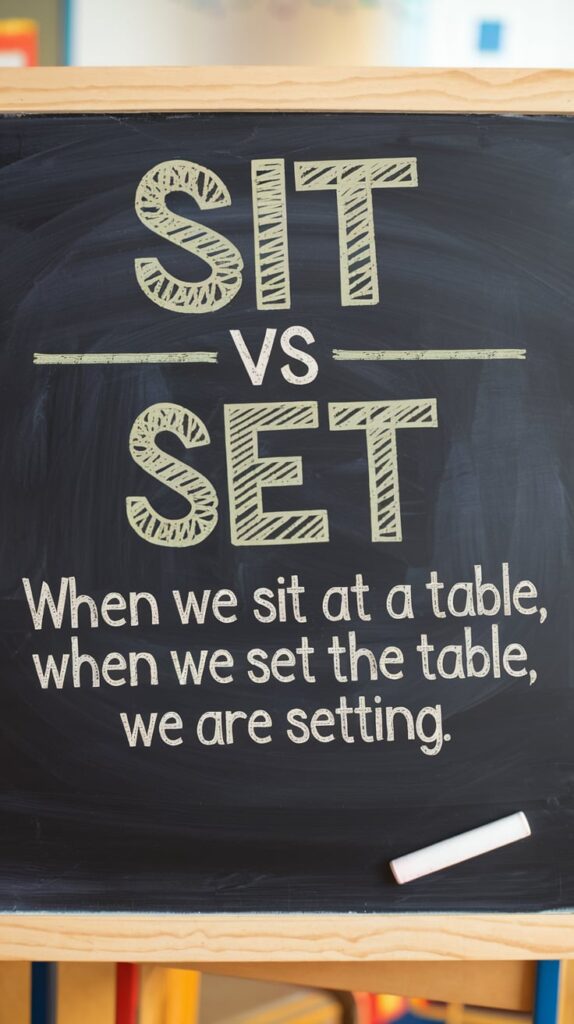Introduction
Understanding the distinction between “sit” vs “set” is crucial for anyone aiming to master the English language. These two verbs often confuse speakers and writers alike,
leading to common mistakes that can affect clarity and communication. In this article, we’ll dive deep into the meanings, uses, and common errors associated with “set” vs “sit.”
By the end, you’ll feel confident using both words correctly in your writing and conversations.
like more : Understanding WYF Meaning in Text – Grammar Beacon
What Does “Set” Mean?
The verb “set” primarily functions as a transitive verb. This means it generally requires a direct object to complete its meaning. The essence of “set” revolves around the ideas of arranging,
positioning, or establishing something. It conveys a sense of action that results in an outcome.
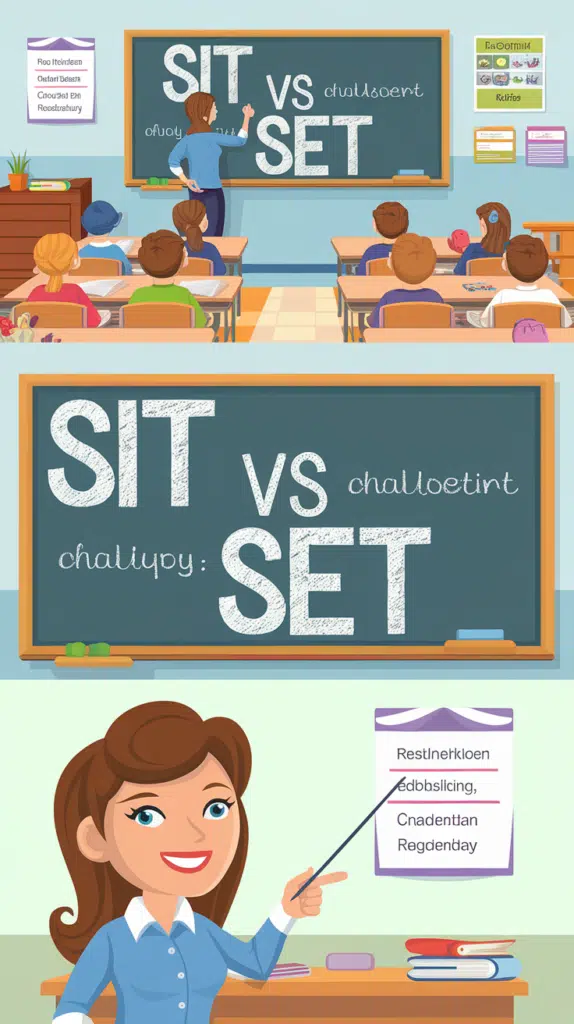
What Are the Sentence Examples with “Set”?
To illustrate how to use “set” effectively, here are several examples:
- She set the table for dinner, arranging the plates and silverware meticulously.
- The coach set a strategy for the game that impressed everyone.
- After careful consideration, he set his goals for the upcoming year.
These examples highlight the dynamic and action-oriented nature of “set,” showcasing its application in various contexts.
When to Use the Word “Set” in a Sentence?
You should use “set” when indicating the act of placing or arranging something. Here are some scenarios where “set” is appropriate:
- Before we eat, please set the table.
- The director set the filming schedule last week.
In both instances, “set” denotes an active process of organizing or establishing something.
like more : Artist vs Artisan: Understanding the Key Differences – Grammar Beacon
How Often is the Word “Set” Used in a Sentence?
“Set” is a frequently used word in English, appearing often in both written and spoken forms. Its versatility allows it to apply in various situations, ranging from everyday tasks to more abstract concepts like setting goals or deadlines.
What Are the Synonyms of “Set”?
Some synonyms for “set” include:
- Arrange
- Place
- Establish
- Fix
- Position
Using these synonyms can enhance your vocabulary and provide alternative ways to convey similar meanings.
What Does “Sit” Mean?
In contrast, “sit” functions as an intransitive verb. This means it does not take a direct object. “Sit” refers to the act of resting one’s weight on a surface, typically a chair or the ground.
It describes a state of being rather than an action directed towards an object.
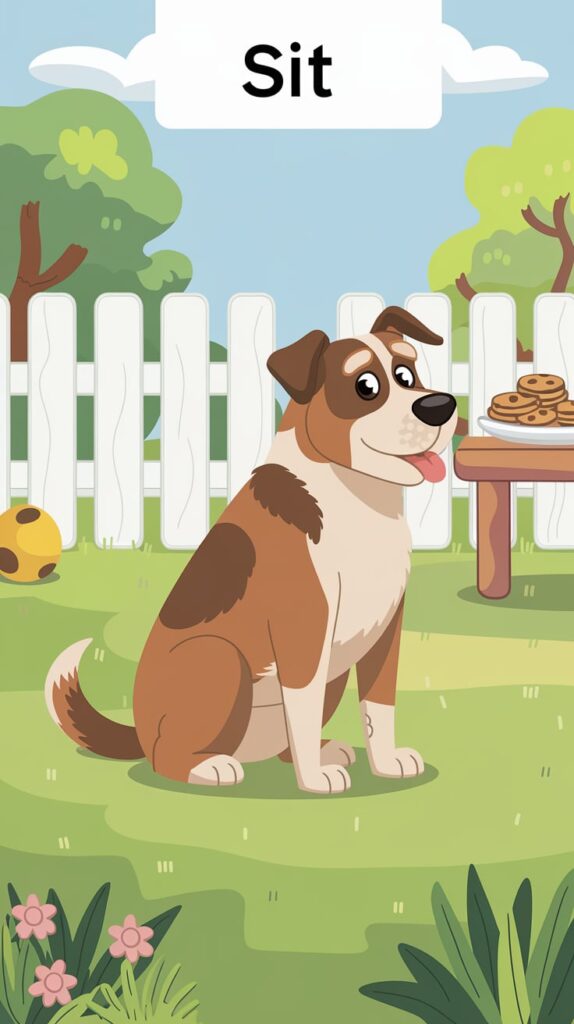
What Are the Sentence Examples with “Sit”?
To better understand “sit,” consider these examples:
- I love to sit by the window and read during the afternoon.
- The children sat on the carpet while the teacher read a story.
- He sat down heavily after a long day at work.
These sentences illustrate the straightforward nature of “sit” as an action involving a resting position.
When to Use the Word “Sit” in a Sentence?
Use “sit” when referring to the act of being seated or resting. Here are some contexts where “sit” is applicable:
- Please sit down and make yourself comfortable.
- They always sit together during lunch breaks.
In these instances, “sit” effectively communicates the action of resting.
like more : Devine vs Divine: Getting the Right Word – Grammar Beacon
How Often is the Word “Sit” Used in a Sentence?
“Sit” is also a common word, frequently used in daily conversation. Its simple and direct meaning makes it easy to incorporate into a variety of contexts.
What Are the Synonyms of “Sit”?
Synonyms for “sit” include:
- Perch
- Rest
- Settle
- Lounge
These alternatives can enrich your writing and enhance your vocabulary.
How is the Pronunciation of “Sit” vs “Set”?
The pronunciation of “set” rhymes with “met,” while “sit” rhymes with “hit.” This distinction is essential for clear communication, as mixing up the two can lead to misunderstandings.
Comparison Between “Sit” and “Set”
Why Are “Sit” and “Set” Misused and Interchangeably in English?
The confusion between “sit” vs “set” often arises from their similar sounds and the fact that both involve some form of placement. However, it’s vital to remember that “set” usually requires an object,
while “sit” denotes a state of being. Misusing these words can lead to confusion and ambiguity.
Are “Set” and “Sit” Among the Most Commonly Misused English Words?
Yes, “set” vs “sit” frequently appear on lists of commonly misused words. Their similarities can lead to errors in both speech and writing, particularly for English language learners and non-native speakers.
Sit or Set: When Should Each Be Used?
What Do Set and Sit Mean?
- Set: To arrange or position something actively, often involving a direct object.
- Sit: To rest one’s weight on a surface passively, not requiring a direct object.
Set:
- Usage: Primarily used when referring to arranging items or establishing conditions.
- Examples:
- He set the stage for the performance before the audience arrived.
- The teacher set a deadline for the assignment submission.
Sit:
- Usage: Refers to the act of resting or occupying a seated position.
- Examples:
- She sat in the front row during the lecture.
- They sat together on the bench at the park.
Origins of Set and Sit
Set:
The word “set” has its origins in Old English “settan,” which means to cause to sit or to put something in a specified place. This historical context underlines its active, purposeful nature and the idea of arranging or positioning.
Sit:
Conversely, “sit” comes from Old English “sittan,” which means to be in a seated position or to rest. This origin reflects its more passive meaning, emphasizing a state of being rather than action.
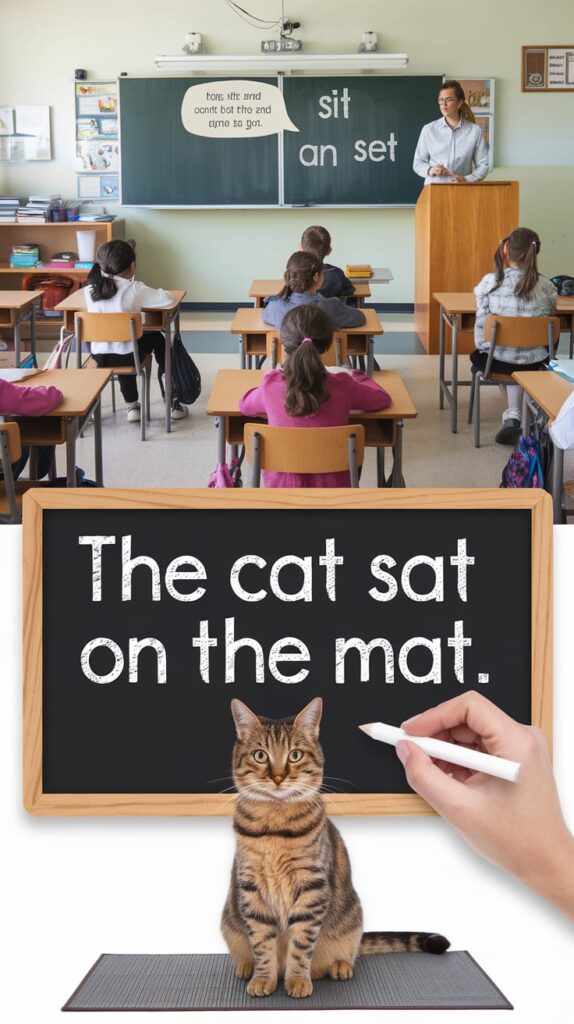
A Simple Tense Table for Set and Sit
| Tense | Set | Sit |
| Present Simple | set | sit |
| Present Continuous | is/are setting | is/are sitting |
| Present Perfect | has/have set | has/have sat |
| Past Simple | set | sat |
| Future Simple | will set | will sit |
This table helps clarify how each verb conjugates across different tenses, making it easier to understand their usage in different contexts.
Should You Use Sit or Set?
When in Doubt, Consider the Action
When you’re uncertain whether to use “set” or “sit,” ask yourself the following questions:
- Am I arranging or positioning something? If yes, use “set.”
- Am I referring to resting or being in a seated position? If yes, use “sit.”
This simple guideline will help you choose the correct word and avoid confusion.
Set vs Sit: Examples in Context
Set:
Imagine you’re preparing for a family gathering. You need to set the table with plates, forks, and glasses before your guests arrive. This scenario exemplifies how “set” functions as a verb indicating preparation and action.
Sit:
Now, picture a classroom environment. The teacher instructs students to sit down before starting the lesson. This illustrates the use of “sit” to denote a simple resting position.
Common Mistakes to Avoid
Misusing “Set” and “Sit”
One of the most common mistakes is using “set” when “sit” is appropriate, and vice versa. For example, saying “I will set down” instead of “I will sit down” confuses the intended meaning.
Incorrect Sentence Examples
- Incorrect: I’m going to set down on the chair.
- Correct: I’m going to sit down on the chair.
Remember, “set” involves action, while “sit” indicates a state of rest.
Practical Tips for Mastering Set and Sit
Contextual Practice
To master the difference between “set” and “sit,” practice using both words in various sentences. Here are some examples to get you started:
Set:
“I will set my priorities for the week.”
“They set the deadline for the project submission.”
Sit:
“Can you sit next to me during the movie?”
“She prefers to sit by the garden.”
Flashcards for Vocabulary
Creating flashcards can be an effective way to remember the meanings and uses of “set” and “sit.” Write “set” on one side and a definition or example on the other. Do the same for “sit.” Regularly review these cards to reinforce your knowledge.
Engaging with Native Speakers
Engaging in conversations with native speakers or participating in language exchange groups is an excellent way to practice. This real-world experience will help you hear how “set” and “sit” are used naturally. Pay attention to the context and try to mimic correct usage.
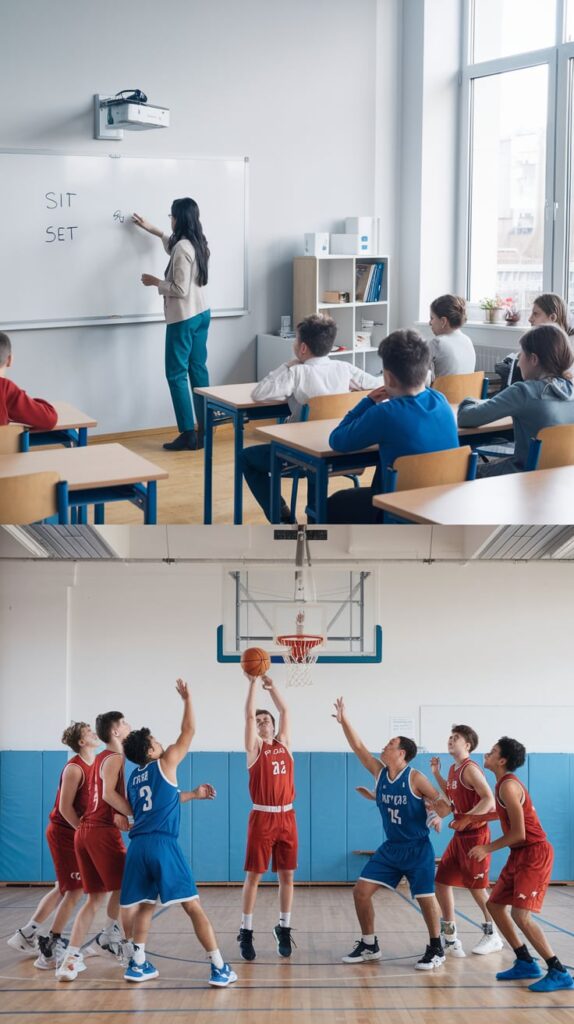
Online Resources
Take advantage of online platforms that offer grammar exercises focusing on these verbs. Websites like Grammarly and Purdue OWL provide resources to help reinforce your understanding.
Analyzing Literature
Reading literature can expose you to various contexts for “set” and “sit.” Pay attention to how authors use these words to enhance their writing. Note their applications and how they contribute to the overall meaning.
Writing Exercises
Try writing short paragraphs that incorporate both “set” and “sit.” This will help you become more comfortable using them in your writing. Here’s a quick exercise:
Write a paragraph describing a family dinner. Use “set” to describe the preparation and “sit” to describe how family members gather around the table.
A Final Look at Sit vs Set
Mastering the difference between “set” vs “sit” is essential for clear and effective communication. By understanding their meanings, proper contexts, and common mistakes, you can significantly improve your language skills.
As you practice and engage with others, remember to pay attention to how you use these verbs. With regular practice, you’ll confidently navigate the nuances of English and avoid common pitfalls.
Set and sit may seem simple, but they hold great importance in everyday language. Whether you’re arranging items or resting comfortably, knowing how to use these verbs correctly will enhance your communication skills.
Sources
For further exploration and understanding, consider these resources:
By consistently applying these insights, you’ll strengthen your command of the English language, making it easier to navigate conversations and writing tasks with confidence.

Steve Rogars is an experienced blogger and language enthusiast at Grammar Beacon. With a passion for clear communication and a keen eye for detail, he shares insights on grammar, writing tips, and language trends. Steve’s engaging style makes learning enjoyable, helping readers enhance their writing skills. When he’s not crafting posts, he enjoys reading, exploring new cultures, and inspiring others to appreciate the beauty of language.

